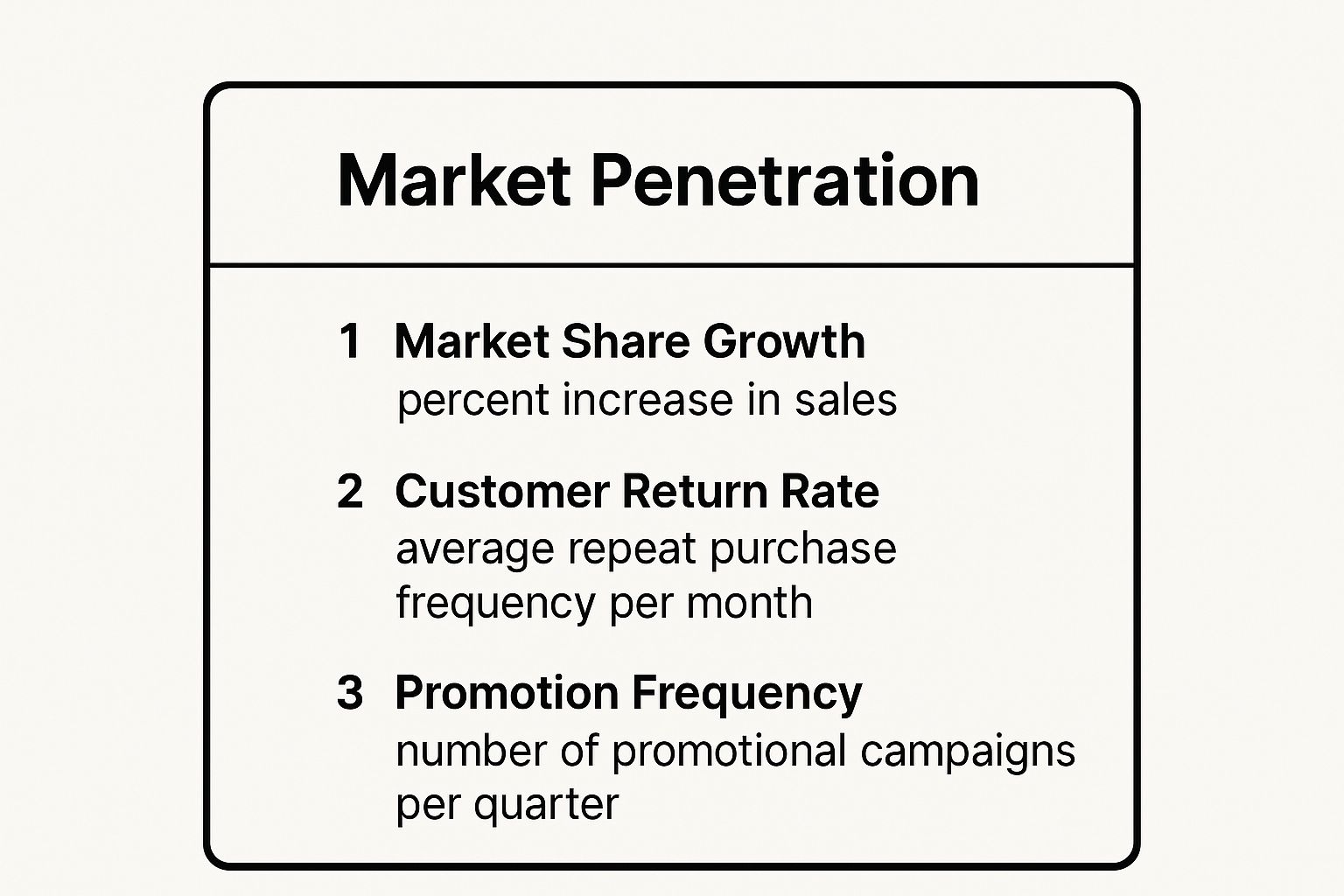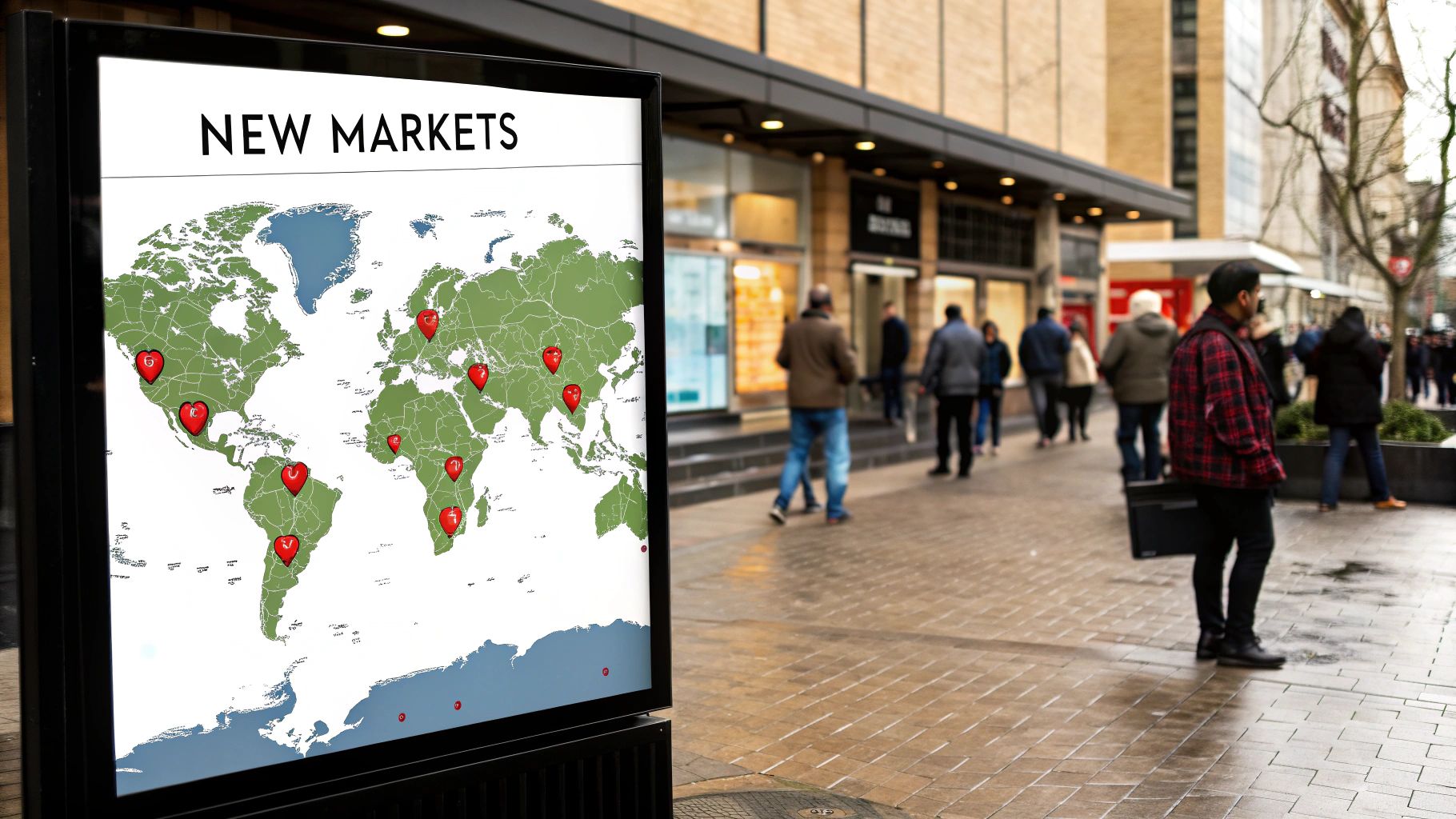Stay Updated with Everything about MDS
Thank you! Your submission has been received!
Oops! Something went wrong while submitting the form.

Chilat Doina
August 2, 2025
In the world of high-stakes ecommerce, standing still means falling behind. For ambitious brands, the question isn't if you should expand, but how. The right approach can catapult your brand into a new league, while the wrong one can drain resources and stall momentum. This guide cuts through the noise, providing a tactical roadmap of proven business expansion strategies tailored for ecommerce leaders.
We will dissect nine distinct pathways to growth, offering actionable frameworks and real-world examples. From aggressive market penetration to strategic alliances, each strategy is broken down into a practical plan you can implement.
Whether you're aiming for your first million or scaling beyond nine figures, these insights will equip you to make your next move your best move. Drawing from the collective wisdom of top performers, we'll explore how elite entrepreneurs execute these plans to build enduring, high-growth enterprises. This article is your structured playbook for significant, sustainable growth. You will learn not just the "what" but the "how," with specific steps for market penetration, product development, diversification, and more. Let's explore the frameworks that will unlock your brand's next level of success.
Market penetration is one of the most fundamental business expansion strategies, focusing on increasing your market share within an existing market. Instead of creating new products or exploring new territories, you concentrate on selling more of your current offerings to your established customer base and attracting customers from your competitors. This approach is often the least risky, as it leverages your existing operational capabilities and deep market knowledge.
This strategy centers on intensifying your marketing and sales efforts. The core objective is to become the dominant player in your current niche. This can be achieved through more aggressive advertising, strategic price adjustments, or by enhancing the perceived value of your products to encourage repeat purchases and lure away rival customers. Think of it as doubling down on what you already do best.
For example, Amazon Prime’s loyalty program is a masterclass in market penetration. By offering benefits like free shipping and exclusive content, Amazon incentivizes existing customers to shop more frequently and exclusively on its platform, effectively capturing a larger share of their total online spending.
This infographic summarizes the key performance indicators (KPIs) to track when implementing a market penetration strategy.

Monitoring these metrics helps you gauge the effectiveness of your campaigns in driving both sales volume and customer loyalty.
Market development is a powerful business expansion strategy where you introduce your existing products to entirely new markets. This could mean expanding into new geographic regions, targeting different demographic segments, or identifying new institutional buyers. This approach leverages the success of your proven products while tapping into fresh, previously unexplored customer bases.

The core idea behind market development is to find new arenas where your current offerings can thrive. Instead of creating something new, you find new customers for what you already have. This involves comprehensive market research to identify viable opportunities and understand the unique needs, regulations, and cultural nuances of the new target audience. Success depends on adapting your marketing message and distribution channels to resonate with this new segment.
For instance, Uber’s global expansion is a prime example of market development. The company took its established ride-sharing service from its initial U.S. market and methodically launched it in cities worldwide. It adapted its app, payment methods, and marketing campaigns to fit local languages, currencies, and transportation habits, effectively creating new markets for its existing service.
Product development is one of the most innovative business expansion strategies, focusing on creating new products to serve your existing market. Instead of selling the same items, you leverage your brand loyalty and deep customer knowledge to introduce fresh offerings. This approach helps meet evolving consumer demands and strengthens your position by diversifying your revenue streams.

This strategy capitalizes on the trust you have already built with your audience. The goal is to solve new problems for your current customers or enhance their experience with complementary products. It requires significant investment in research and development (R&D) and a keen understanding of what your market wants next, often before they even know it themselves.
A prime example is Apple, which continuously innovates within its ecosystem. By introducing products like the Apple Watch and AirPods to its established base of iPhone users, Apple successfully created new revenue lines by addressing the interconnected needs of its loyal customers, solidifying its market dominance.
Diversification is one of the boldest business expansion strategies, involving the launch of new products in entirely new markets. This approach carries the highest risk, as it moves your company away from its core competencies, but it also offers the potential for the highest rewards. It's a method for creating entirely new revenue streams and spreading risk across different industries, insulating your business from market-specific downturns.
This strategy is about venturing into uncharted territory. Unlike other strategies that build on existing products or markets, diversification requires developing new capabilities to serve a completely different customer base. This can be achieved through internal development or, more commonly, by acquiring an existing company in the target industry. The goal is to build a portfolio of businesses that can create long-term, resilient growth.
A prime example is Amazon's evolution from an online bookseller to a global conglomerate. Its launch of Amazon Web Services (AWS) was a classic diversification move, entering the cloud computing market, which was entirely unrelated to its ecommerce core. Today, AWS is a massive profit driver for the company, showcasing the immense potential of this strategy.
Strategic partnerships are a powerful business expansion strategy where you collaborate with other companies to achieve shared goals while remaining independent. This approach allows you to access new markets, technologies, or distribution channels by leveraging a partner's existing strengths, avoiding the heavy costs associated with building those capabilities from scratch. It is a mutually beneficial arrangement designed for scalable growth.

This strategy is built on synergy. You identify a non-competing business whose customer base, products, or services complement your own. By forming an alliance, both parties can offer a more compelling value proposition to their customers, unlock new revenue streams, and enhance their market presence. The key is to find a partner where the combined effort is greater than the sum of its parts.
A classic example is Spotify's partnership with telecommunications companies like AT&T. By bundling Spotify Premium with mobile plans, Spotify gains immediate access to a massive, engaged user base, while the telecom partner enhances its service offerings, making its plans more attractive to potential customers.
Building a strong network is crucial for finding the right partners. Engaging with an ecommerce community can connect you with like-minded entrepreneurs and potential collaborators.
Franchising is a powerful business expansion strategy where you (the franchisor) grant a license to an independent operator (the franchisee) to use your brand, business model, and operational systems in exchange for fees and royalties. This model allows for rapid geographic expansion with lower capital expenditure from the parent company, as franchisees fund their own locations. It leverages the entrepreneurial drive of local owners while maintaining brand consistency.
This strategy involves codifying your entire business operation into a replicable package. The franchisor provides the brand identity, products, and a comprehensive support system, including training and marketing. The franchisee invests their own capital to open and run a location, adhering strictly to the established standards. This creates a symbiotic relationship where the franchisor achieves scale and the franchisee runs a business with a proven track record.
McDonald's is the quintessential example. Its global dominance was built not by owning every restaurant but by perfecting a franchise system that ensures a consistent Big Mac and fries experience whether you are in Tokyo or Texas. This was pioneered by Ray Kroc, who saw the potential for rapid, standardized growth through franchising.
Mergers and acquisitions (M&A) represent one of the most transformative business expansion strategies, allowing a company to achieve rapid growth by combining with or purchasing another business. This approach can instantly grant access to new markets, established customer bases, proprietary technology, or valuable talent. Instead of building capabilities from scratch, M&A lets you acquire them outright, which can be a powerful way to eliminate competition and scale operations overnight.
This strategy involves identifying a target company that aligns with your strategic goals, conducting thorough due diligence, negotiating terms, and finally, integrating the acquired entity into your existing operations. The goal is to create a combined organization that is more valuable and competitive than the two separate companies were. Success hinges on a well-executed integration plan that aligns everything from technology systems to company culture.
A prime example is Facebook's acquisition of Instagram and WhatsApp. Rather than building competing platforms, Facebook purchased these fast-growing social networks to capture new user demographics and solidify its dominance in the social media landscape, effectively buying its future growth and neutralizing major threats.
Digital transformation is a powerful business expansion strategy that involves fundamentally changing how you operate and deliver value to customers by integrating digital technology into all areas of your business. More than just launching an online store, it encompasses leveraging e-commerce, digital marketing, data analytics, and automation to expand reach, streamline operations, and innovate your business model for the digital era. This strategy is essential for staying competitive in a world where customer journeys begin online.
This strategy centers on placing technology and data at the core of your operations to meet modern consumer expectations. The objective is to create a seamless, data-driven, and highly efficient customer experience across all digital touchpoints. This can involve anything from building a robust e-commerce platform and mobile app to automating inventory management and using AI to personalize marketing communications. It’s about reimagining your business for a digital-first world.
For instance, Domino's Pizza transformed itself from a traditional fast-food chain into a tech-first e-commerce powerhouse. By investing heavily in a user-friendly mobile app, an innovative Pizza Tracker, and multiple digital ordering channels, Domino's made the customer experience faster and more convenient, leading to explosive growth and market leadership.
Licensing and technology transfer is a powerful business expansion strategy that involves granting other companies the right to use your intellectual property (IP). This can include your brand name, characters, patented technology, or proprietary business processes in exchange for royalties or fees. This approach allows for rapid expansion into new markets or product categories with minimal capital investment, leveraging the manufacturing, distribution, and marketing capabilities of your partners.
This strategy monetizes your intangible assets by allowing others to produce and sell products based on your IP. Instead of building factories or opening new storefronts yourself, you partner with established companies that can do it for you. Your role shifts to managing the brand and ensuring quality control, while your licensee handles the operational heavy lifting. This creates a high-margin revenue stream that can scale globally without corresponding operational complexity.
A prime example is Disney's merchandise licensing. Disney doesn't manufacture every toy, apparel item, or lunchbox featuring its characters. Instead, it licenses these rights to third-party manufacturers who have expertise in those specific product areas, allowing the Disney brand to have an immense physical retail presence worldwide.
Navigating the landscape of business expansion requires more than just ambition; it demands a strategic, calculated approach. We have explored a comprehensive suite of growth blueprints, from the focused intensity of market penetration and the innovative drive of product development to the transformative potential of mergers and acquisitions. Each of these business expansion strategies represents a distinct pathway to scale, tailored for different market conditions, resource levels, and long-term objectives.
The critical takeaway is that growth is not a one-size-fits-all endeavor. The right strategy for a nimble startup leveraging strategic partnerships will differ vastly from an established brand pursuing global market development. Your task now is not to chase every opportunity but to engage in a rigorous process of self-assessment. The most successful ecommerce leaders don't just pick a strategy; they align it perfectly with their brand's DNA.
To move from insight to implementation, consider these essential steps:
The journey from a promising ecommerce store to a dominant market force is paved with these critical decisions. The strategies outlined-from expanding your digital footprint to acquiring a competitor-are your tools. Choosing the correct one at the pivotal moment is what separates stagnant brands from enduring enterprises. This decision is the true starting line for your next chapter of growth. The path you select will define your operational priorities, shape your team, and ultimately determine the trajectory of your brand for years to come. Execute your chosen strategy with precision, adapt to market feedback, and build the legacy you envision.
Tired of navigating these high-stakes decisions alone? Surround yourself with elite entrepreneurs who have successfully executed these very business expansion strategies. The Million Dollar Sellers community is a private mastermind of vetted, 7 and 8-figure ecommerce sellers who share actionable insights and proven playbooks to accelerate growth and avoid costly mistakes. Apply to join Million Dollar Sellers and start building your empire with the right people beside you.
Join the Ecom Entrepreneur Community for Vetted 7-9 Figure Ecommerce Founders
Learn MoreYou may also like:
Learn more about our special events!
Check Events